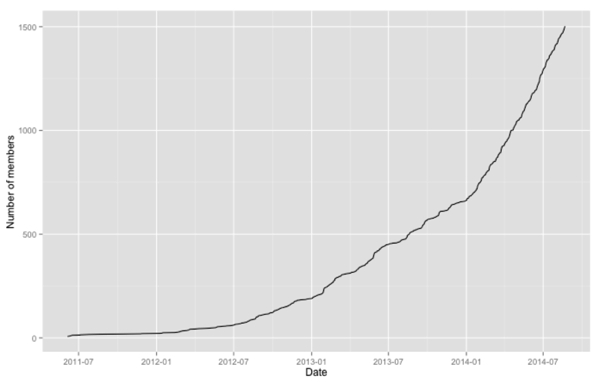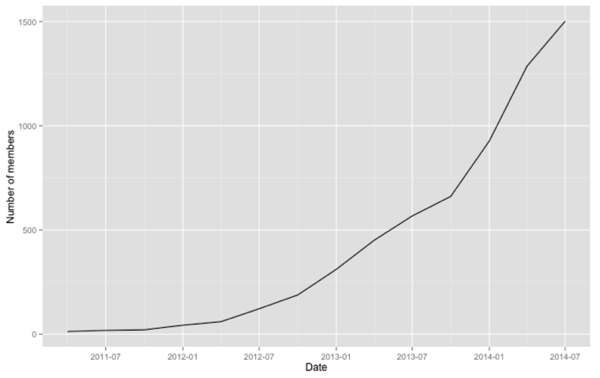R: ggplot - Cumulative frequency graphs
In my continued playing around with ggplot I wanted to create a chart showing the cumulative growth of the number of members of the Neo4j London meetup group.
My initial data frame looked like this:
> head(meetupMembers)
joinTimestamp joinDate monthYear quarterYear week dayMonthYear
1 1.376572e+12 2013-08-15 13:13:40 2013-08-01 2013-07-01 2013-08-15 2013-08-15
2 1.379491e+12 2013-09-18 07:55:11 2013-09-01 2013-07-01 2013-09-12 2013-09-18
3 1.349454e+12 2012-10-05 16:28:04 2012-10-01 2012-10-01 2012-10-04 2012-10-05
4 1.383127e+12 2013-10-30 09:59:03 2013-10-01 2013-10-01 2013-10-24 2013-10-30
5 1.372239e+12 2013-06-26 09:27:40 2013-06-01 2013-04-01 2013-06-20 2013-06-26
6 1.330295e+12 2012-02-26 22:27:00 2012-02-01 2012-01-01 2012-02-23 2012-02-26The first step was to transform the data so that I had a data frame where a row represented a day where a member joined the group. There would then be a count of how many members joined on that date.
We can do this with dplyr like so:
library(dplyr)
> head(meetupMembers %.% group_by(dayMonthYear) %.% summarise(n = n()))
Source: local data frame [6 x 2]
dayMonthYear n
1 2011-06-05 7
2 2011-06-07 1
3 2011-06-10 1
4 2011-06-12 1
5 2011-06-13 1
6 2011-06-15 1To turn that into a chart we can plug it into ggplot and use the cumsum function to generate a line showing the cumulative total:
ggplot(data = meetupMembers %.% group_by(dayMonthYear) %.% summarise(n = n()),
aes(x = dayMonthYear, y = n)) +
ylab("Number of members") +
xlab("Date") +
geom_line(aes(y = cumsum(n)))
Alternatively we could bring the call to cumsum forward and generate a data frame which has the cumulative total:
> head(meetupMembers %.% group_by(dayMonthYear) %.% summarise(n = n()) %.% mutate(n = cumsum(n)))
Source: local data frame [6 x 2]
dayMonthYear n
1 2011-06-05 7
2 2011-06-07 8
3 2011-06-10 9
4 2011-06-12 10
5 2011-06-13 11
6 2011-06-15 12And if we plug that into ggplot we’ll get the same curve as before:
ggplot(data = meetupMembers %.% group_by(dayMonthYear) %.% summarise(n = n()) %.% mutate(n = cumsum(n)),
aes(x = dayMonthYear, y = n)) +
ylab("Number of members") +
xlab("Date") +
geom_line()If we want the curve to be a bit smoother we can group it by quarter rather than by day:
> head(meetupMembers %.% group_by(quarterYear) %.% summarise(n = n()) %.% mutate(n = cumsum(n)))
Source: local data frame [6 x 2]
quarterYear n
1 2011-04-01 13
2 2011-07-01 18
3 2011-10-01 21
4 2012-01-01 43
5 2012-04-01 60
6 2012-07-01 122Now let’s plug that into ggplot:
ggplot(data = meetupMembers %.% group_by(quarterYear) %.% summarise(n = n()) %.% mutate(n = cumsum(n)),
aes(x = quarterYear, y = n)) +
ylab("Number of members") +
xlab("Date") +
geom_line()
About the author
I'm currently working on short form content at ClickHouse. I publish short 5 minute videos showing how to solve data problems on YouTube @LearnDataWithMark. I previously worked on graph analytics at Neo4j, where I also co-authored the O'Reilly Graph Algorithms Book with Amy Hodler.
